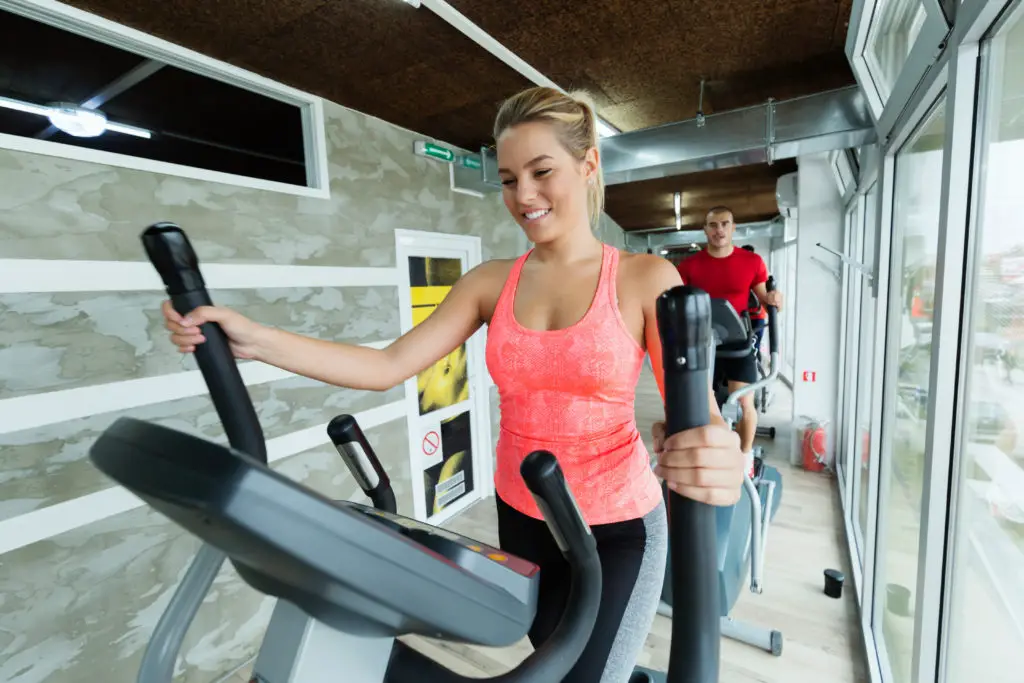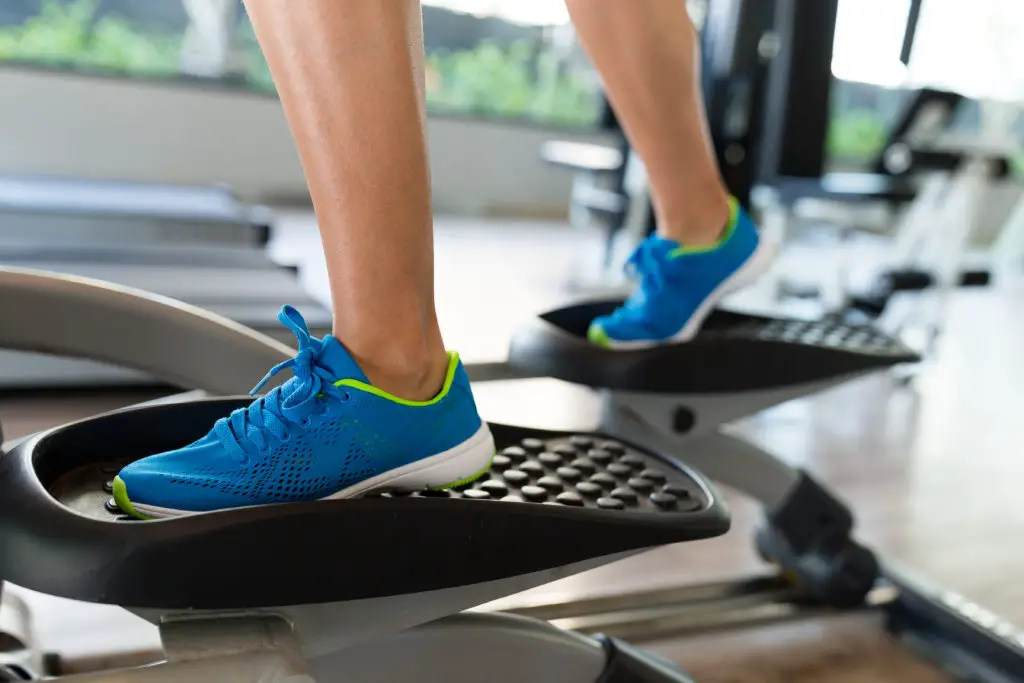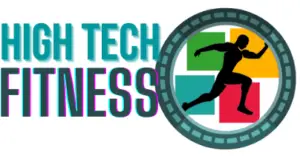
Ellipticals are some of the most popular pieces of workout equipment used worldwide. They are great for working muscles in different areas of the body while providing an exercise routine that is not so strenuous. However, will going backward on an elliptical offer the same results after a workout?
Performing backward motions on an elliptical is something that fitness experts recommend because it adds a new element to your routine, engages new muscles, burns more calories, and provides an indirect form of cross-training.
This article will explain why you should go backward on the elliptical, offer tips you can try that incorporate going backward, highlight the differences between going forward and backward on an elliptical, and provide workout examples that use both forms of movement.
» Related: How Long Does it Take to Burn 1000 Calories on an Elliptical?
Page Contents
Why You Should Go Backwards on an Elliptical

Until now, you may not have known that it is possible to pedal backward on an elliptical. However, pedaling backward imparts many benefits that improve your health and your workout. These include but are not limited to:
- Engage a Different Muscle Group – Working on an elliptical backward engages your rectus femoris muscle, which is a part of the quads. Moving forward works a different set of muscles to focus on two muscle groups instead of one. The more muscle groups you work on, the more effective the workout.
- Burn More Calories – Using the reverse motion on the elliptical helped users burn 7% more calories than they did going forward. So, combining the forward and backward motions will help elliptical users burn more calories.
- Add Excitement to Your Workout – Only using the elliptical forward becomes old really quickly. Incorporating backward pedaling adds a fun challenge that keeps you from getting bored, helps you stay committed to your workout, and prevents your body from getting used to your workout routine, which can stall calorie-burning goals.
- Increase Workout Efficiency – Since you are working two muscle groups instead of one by going both forward and backward, you can accomplish more in the same or shorter time. Incorporating both motions is considered a form of cross-training and works most of the major lower body muscles simultaneously.
- Helpful When Recovering from Injury – Using the elliptical is a low-impact form of exercise that can assist you when healing, and it is a way to make traditional rehabilitation more appealing.
Going backward is also a great cardio workout and allows you to achieve better posture, making spending time on an elliptical more effective.
Built-In Backwards Functionality
Some elliptical machines even have a feature that allows you to change the direction of the pedals, so you can choose to go forwards or backwards. Going backwards on an elliptical can provide a different workout by engaging different muscle groups and changing the way your body moves.
However, it’s important to be cautious when using this feature, as it can be easy to lose your balance or lose track of your footing. It’s a good idea to start slowly and increase your speed gradually to get used to the movement before increasing your intensity. It’s also a good idea to pay attention to the instructions provided by the manufacturer and to use the machine in a safe and controlled manner.
Now that you know all of the great things that pedaling backward can do for you, you may be wondering how you can start doing it the next time you are on the elliptical.
Going Forward vs. Backward on the Elliptical
It is important that you pedal both forwards and backward on the elliptical because each motion imparts varying benefits. This way, you will accomplish more in a single session.
The below table highlights the main benefits of forward and backward movement on an elliptical:
| Going Forward on Ellipticals | Going Backward on Ellipticals |
| Targets the quadriceps and glutes | Targets the hamstrings and hip extensors |
| Takes less effort and can be done quickly when you only have a few minutes to work out | Takes more effort, so you go slower, but works on your balance |
| Provides a full-body workout so that you don’t have to use multiple pieces of equipment | Improves cardiovascular health and burns more calories |
How to Incorporate Backward Movement on Ellipticals

Pedaling backward may seem difficult because it is not as natural as going forward, but there are many fun ways you can add it to your elliptical routine so that it becomes second nature:
- Low angle of the pedals, light tension, fast speed
- Low pedal angle, heavy tension, moderate speed
- High pedal angle, light tension, fast speed
- High pedal angle, heavy tension, moderate speed
You can create several other combinations by modifying the same variables of pedal angle, tension, and speed to spice up your workout. You can also try squatting or changing the position of your feet on the pedals to engage even more muscles. Another way to build in going backward is to use it as a cool down at the end at low intensity and speed.
Going forward is what most people do because it is second nature and can provide results quickly. However, backward pedaling provides a welcome challenge and is a must-try for those looking to improve their heart health. If you want to start pedaling backward without thinking about where to include it, there are many regimens available online for you to try.
Forward and Backward Elliptical Workouts
There are many pre-made workouts designed by fitness experts to help you get started using both the forward and backward motion. The following workouts can be completed in 30 minutes or less:
Front to Back
In this regimen, you switch back and forth between forward and backward pedaling, with the incline of the elliptical set at 9% the whole time and adjusting the resistance in a rhythmical pattern. The 9-minute no-hands portion encourages you to use your core as well, so you can target a wide range of muscles effectively. It takes 30 minutes to complete.
20 Minute High-Intensity Interval Training
This comprehensive workout combines forward and backward pedaling with a wide range of intensities and resistances to burn the maximum number of calories and challenge the heart. The point of this type of workout is to switch between quick, intense workout streaks with low-intensity recovery breaks so that you can get in a solid amount of exercise in a short amount of time.
30 Minute Sprint Build
Sprinting on the elliptical is the name of the game in this workout! It combines forward and backward hands-off pedaling in the warm-up with alternating arm pushes and pulls at varying resistances. This is the ultimate core, arm, and leg workout that mashes running and using the elliptical together, and it only takes 30 minutes to complete.
Whether you choose one of these workouts or find a different one that suits your workout style, you will be well on your way to making backward pedaling on the elliptical a regular part of your routine.
Conclusion
Going backward on the elliptical is definitely something you should consider doing. It allows you to work more muscles, burns more calories, makes workouts more interesting, and is a great help when recovering from injury. Plus, you can incorporate backward pedaling in many ways, whether through changing the elliptical settings or trying a pre-made workout.
